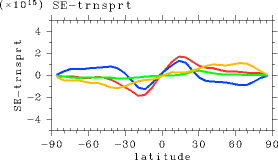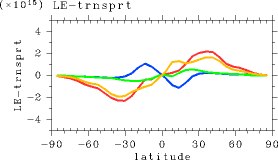E. Atmospheric Structure of in Equilibrium States |
Meridional Energy Transport in Experiment S1380
In experiment S1380, the magnitude of dry static energy transport is similar to that of latent heat energy transport (Figure 1). The mean meridional circulation and transient disturbance component have almost same contributions to dry static energy transport. The distribution of meridional latent heat energy transport shows that water vapor is transported to high latitude region from 20 latitude north and south where difference between evaporation and precipitation is maximum. The transient disturbance component, which is considered to due to baroclinic instability is dominant to latent heat energy transport in high latitude region. In low latitude region from 20 latitude north and south, mean meridional circulation transports latent heat energy to equatorward and transient disturbances transport to poleward. The net latent heat energy transport is poleward.
(a) 
(b) 
Figure 1:
Meridional energy transport in experiment S1380 (W). (a): Meridional dry static energy transport. (b): Meridional latent heat energy transport. Red: total transport. Blue: transport by the mean meridional circulation. Green: transport by stationary disturbances. Light brown: transport by transient disturbances.The total transport, transports by mean meridional circulation, stationary disturbances, and transient disturbances are defined as follows. The total transport of physical variables X is
and that by mean meridional circulation is
and that by stationary disturbances is
and that by transient disturbances is
v is meridional velocity, overline denotes time mean, bracket and asterisk denotes zonal mean and its deviation, and prime denotes deviation from time mean value. Note that vertical mean component is subtracted in transport by mean meridional circulation.